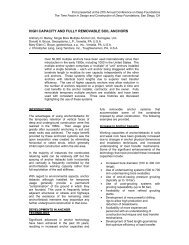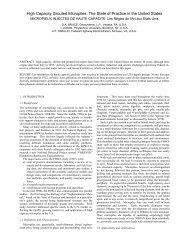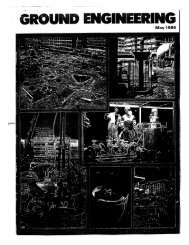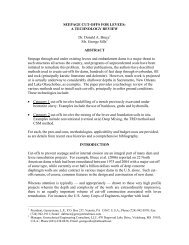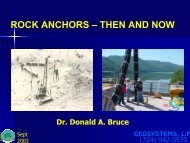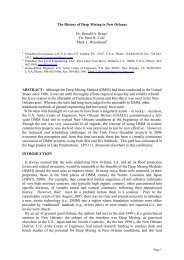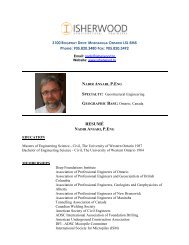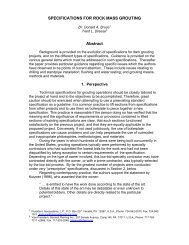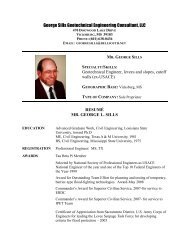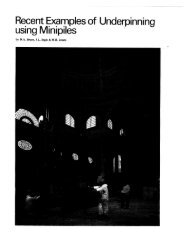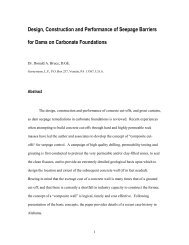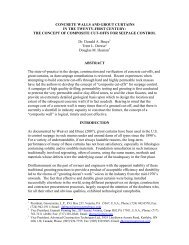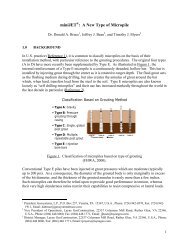1 Dam Remediation by Anchors and Cut-Offs: A ... - Geosystems, LP
1 Dam Remediation by Anchors and Cut-Offs: A ... - Geosystems, LP
1 Dam Remediation by Anchors and Cut-Offs: A ... - Geosystems, LP
You also want an ePaper? Increase the reach of your titles
YUMPU automatically turns print PDFs into web optimized ePapers that Google loves.
factors influencing rock/grout bond stress development; anchor spacing; grout<br />
cover/str<strong>and</strong> spacing; <strong>and</strong> grout mix design.<br />
Construction (Chapter 7)<br />
As noted above, there was a strong bias in the 1974 document towards construction,<br />
largely, it may be assumed, because practice far led theory. Furthermore, much of<br />
what was described in 1974 remains valid, especially with respect to issues relating to<br />
grouts, grouting <strong>and</strong> tendon placement. Certain features, such as a reliance on core<br />
drilling, the use of a “fixed anchorage” (i.e., the use of a plate) at the lower end of<br />
multistr<strong>and</strong> tendons, <strong>and</strong> specific water take criteria to determine the need for<br />
“consolidation grouting” are, however, no longer valid.<br />
The 2004 version exp<strong>and</strong>s upon the 1996 guidance, itself a radical<br />
improvement over its two immediate predecessors, <strong>and</strong> is strongly permeated <strong>by</strong> an<br />
emphasis on quality control <strong>and</strong> assurance. For example, practical recommendations<br />
are provided on the fabrication of tendons (including the pregrouting of<br />
encapsulations) <strong>and</strong> storage h<strong>and</strong>ling <strong>and</strong> insertion. Drilling methods are best “left to<br />
the discretion of the contractor, wherever possible,” although specifications should<br />
clearly spell out what is not acceptable or permissible. In rock, rotary percussion is<br />
favored, <strong>and</strong> the drilling tolerance for deviation of 2º is “routinely achievable,” while<br />
smaller tolerances may be difficult to achieve or to measure. Holes open for longer<br />
than 8 to 12 hours should be recleaned prior to tendon insertion <strong>and</strong> grouting.<br />
The acceptance criterion for water pressure testing is adjusted to 10.3 liters in<br />
10 minutes at 0.035 MPa for the entire hole. Technical background is provided on<br />
the selection of this threshold (based on fissure flow theory). Holes with artesian or<br />
flowing water are to be grouted <strong>and</strong> redrilled prior to water pressure testing. The<br />
pregrout (generally WCR = 0.5 to 1.0 <strong>by</strong> weight) is to be redrilled when it is weaker<br />
than the surrounding rock. When corrugated sheathing is preplaced, a water test<br />
should be conducted on it also, prior to any grouting of its annulus.<br />
The treatment of grouting is considerably exp<strong>and</strong>ed <strong>and</strong> features a new<br />
decision tree to guide in the selection of appropriate levels of QC programs. Holes<br />
are to be grouted in a continuous operation not to exceed 1 hour, with grouts batched<br />
to within 5% component accuracy. The value of testing grout consistency <strong>by</strong> use of<br />
specific gravity measurements is illustrated. Special care is needed when grouting<br />
large corrugated sheaths; multiple stages may be required to avoid flotation or<br />
distortion. The cutting of “windows” in the sheath (to equalize pressures) is strictly<br />
prohibited.<br />
Stressing, Load Testing <strong>and</strong> Acceptance (Chapter 8)<br />
Given the professional experience <strong>and</strong> background of the drafting committee, it is<br />
surprising, in retrospect, to note the very simplistic contents of the 1974 document:<br />
− “proof test” every anchor to ≥ 115% “transfer” load (to maximum 80% GUTS),<br />
− hold for up to 15 minutes (but no creep criterion is given),<br />
− lock-off at 50 to 70% GUTS,<br />
− alignment load = 10% of Test Load, with movement only apparently recorded at<br />
this Test Load (115 to 150% transfer load). “If measured <strong>and</strong> calculated<br />
6



